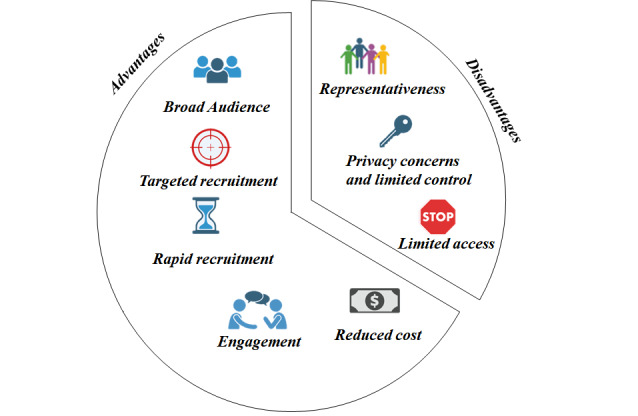Chapter 2: Developing a Research Study
Module 7: Participant Recruitment and Retainment
What’s research without participants? This module provides strategies for increasing participation in digital research, focusing on accessible recruitment, outreach to hard-to-reach communities, and addressing barriers to participation.
Learning Objectives
- Explore the TCPS 2 (2022) for information about ethical incentives for participation
- Consider the advantages and disadvantages of social media recruitment
- Consider barriers and facilitators to digital research participation
Case Study
Dr. Keith is struggling with low participation in his digital research study. During a team meeting, he proposes several strategies to boost engagement, including offering additional incentives. His colleague, suggests using social media advertising programs to target potential participants. While this approach could increase visibility, Dr. Keith is uneasy about allowing an algorithm to determine who sees the research opportunity.
“In the bentwood of these data sets, none of them is straight.”
(Raub, 2018)
How do I find digital research participants?
Finding participants for digital research isn’t just about putting out a call and hoping people sign up.
Recruitment is about making sure the right people actually see it and can participate. One major barrier is digital access. People with disabilities, for example, report lower internet access, fewer devices, and less confidence using technology, making a fully online study difficult to navigate. If your research is digital, ask yourself: Who might be left out?
Can you offer phone interviews, paper surveys, or hybrid options? Can you offer additional support and resources for people participating? Building in flexibility ensures a more inclusive study.
In addition to access to participation, motivation to participate plays a role. People are more likely to participate if they care about the topic, want to contribute to a greater cause, or see a direct benefit, like learning something new.
Offering other ethical incentives can also help, such as gift cards, entry into a draw for a prize, or other gifts of some monetary value. If you are considering using incentives for encouraging research participation, it’s important to consult your institutional Research Ethics Board, as well as the TCPS 2 (2022) for the ethical parameters of these incentives.
However, none of this matters without establishing trust.
Research participants often worry about privacy, data security, and how their information will be used. Being upfront about these concerns, using clear and accessible language, and allowing time for informed consent makes a difference.
Partnering with trusted community organizations is another smart move. A local advocacy group, or a minority researcher on the team can serve as a bridge, connecting you with individuals who may not typically engage in research. At the end of the day, finding digital research participants isn’t just about outreach; it’s about making research feel safe, accessible, and worth their time.
A New Wave: Social Media Recruitment
Social media recruitment is a game-changer; it can reach people who wouldn’t normally engage with research. But it’s not without ethical concerns. Unlike traditional methods, where people opt-in by seeing a flyer or hearing from a community leader, social media recruitment works differently.

Social media platforms track user behaviour, interests, and demographics, meaning that any recruitment ads you put out will be highly targeted. While this can be helpful, it also raises privacy concerns. Many users don’t realize how much of their personal data is being used to tailor their social media content, making highly targeted research invitations feel intrusive or even manipulative.
Another major issue is algorithmic bias. Social media platforms decide which ads, or research studies, users see, and these decisions aren’t always fair (Chen, 2023). If an algorithm prioritizes certain demographics, entire communities could be excluded without researchers even realizing it. This is especially concerning for groups already underrepresented in research, like people with disabilities or those in low-income areas.
Additionally, choices of social media for recruitment can be a blind spot for many academics; in many cases, researchers will share recruitment information across their most-followed and public-facing platforms. These often include more professional forums, such as LinkedIn, or X, and many people outside of these platforms will not see posts.
Despite these challenges, avoiding social media recruitment altogether isn’t the answer. For some hard-to-reach populations, social media may be the only effective way to connect.
Instead, researchers must be transparent about data use, ensure people are clearly informed prior to consenting to participation, and actively work to mitigate bias. Strategies like testing recruitment ads for fairness, collaborating with diverse research teams, and offering alternative ways to participate can make a big difference.
Social media recruitment can be a great resource for increasing inclusivity, but only if researchers approach it with awareness and responsibility.
Below, we visualize several advantages and disadvantages of using social media as a recruitment tool, taken from Oudat & Bakas, 2023. To support screen readers, a table has been created containing the same information as the graphic.
| Advantages | Disadvantages |
|
|

Barriers in Digital Research
You’ve done the work to ensure a private and ethical research space for your online survey. So why do people still say no to research? Sometimes, they’re just not interested in the topic. Maybe the poster wasn’t engaging enough? Other times, it’s more complicated: privacy concerns, lack of trust, digital access barriers, or even just being too busy.
Digital research adds another layer of difficulty. Some potential participants don’t have reliable internet, a computer, or the technology skills to navigate an online study. Others may feel research isn’t meant for them, especially if they don’t see their community represented in other studies.
To reduce participation barriers, offering multiple ways to engage, providing support, and ensuring your survey design is accessible for all participants will support participation.
Ultimately, putting participants first will help you understand how best to reach them. Taking the time to answer questions, showing respect for participants’ time, and ensuring ethical recruitment practices can turn hesitant individuals into engaged contributors.


Feedback/Errata